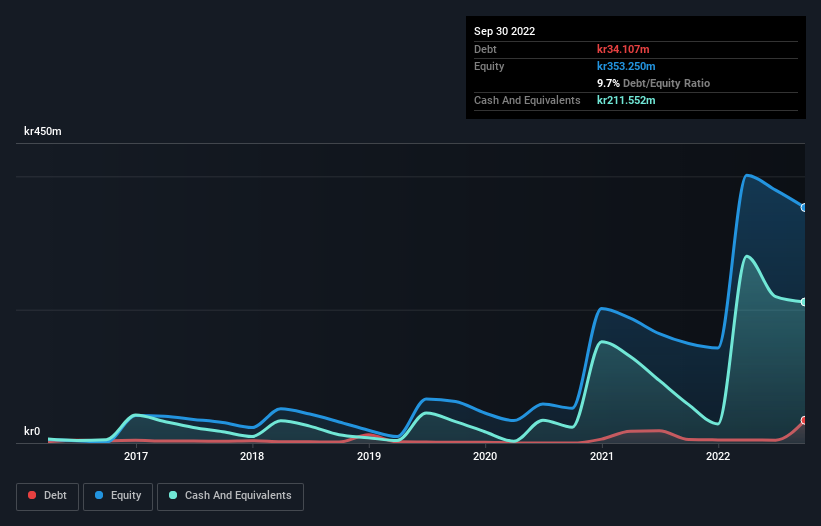
Warren Buffett famously said, 'Volatility is far from synonymous with risk.' When we think about how risky a company is, we always like to look at its use of debt, since debt overload can lead to ruin. As with many other companies Cell Impact AB (publ) (STO:CI) makes use of debt. But the more important question is: how much risk is that debt creating?
When Is Debt A Problem?
Debt assists a business until the business has trouble paying it off, either with new capital or with free cash flow. In the worst case scenario, a company can go bankrupt if it cannot pay its creditors. While that is not too common, we often do see indebted companies permanently diluting shareholders because lenders force them to raise capital at a distressed price. Having said that, the most common situation is where a company manages its debt reasonably well - and to its own advantage. The first step when considering a company's debt levels is to consider its cash and debt together.
See our latest analysis for Cell Impact
How Much Debt Does Cell Impact Carry?
As you can see below, at the end of September 2022, Cell Impact had kr34.1m of debt, up from kr5.10m a year ago. Click the image for more detail. However, it does have kr211.6m in cash offsetting this, leading to net cash of kr177.4m.

How Healthy Is Cell Impact's Balance Sheet?
According to the last reported balance sheet, Cell Impact had liabilities of kr44.3m due within 12 months, and liabilities of kr36.2m due beyond 12 months. Offsetting these obligations, it had cash of kr211.6m as well as receivables valued at kr33.7m due within 12 months. So it can boast kr164.8m more liquid assets than total liabilities.
It's good to see that Cell Impact has plenty of liquidity on its balance sheet, suggesting conservative management of liabilities. Given it has easily adequate short term liquidity, we don't think it will have any issues with its lenders. Simply put, the fact that Cell Impact has more cash than debt is arguably a good indication that it can manage its debt safely. When analysing debt levels, the balance sheet is the obvious place to start. But you can't view debt in total isolation; since Cell Impact will need earnings to service that debt. So when considering debt, it's definitely worth looking at the earnings trend. Click here for an interactive snapshot.
In the last year Cell Impact wasn't profitable at an EBIT level, but managed to grow its revenue by 20%, to kr84m. Shareholders probably have their fingers crossed that it can grow its way to profits.
So How Risky Is Cell Impact?
We have no doubt that loss making companies are, in general, riskier than profitable ones. And in the last year Cell Impact had an earnings before interest and tax (EBIT) loss, truth be told. Indeed, in that time it burnt through kr178m of cash and made a loss of kr102m. With only kr177.4m on the balance sheet, it would appear that its going to need to raise capital again soon. With very solid revenue growth in the last year, Cell Impact may be on a path to profitability. Pre-profit companies are often risky, but they can also offer great rewards. There's no doubt that we learn most about debt from the balance sheet. But ultimately, every company can contain risks that exist outside of the balance sheet. Be aware that Cell Impact is showing 3 warning signs in our investment analysis , and 1 of those is potentially serious...
If, after all that, you're more interested in a fast growing company with a rock-solid balance sheet, then check out our list of net cash growth stocks without delay.
If you're looking to trade Cell Impact, open an account with the lowest-cost platform trusted by professionals, Interactive Brokers.
With clients in over 200 countries and territories, and access to 160 markets, IBKR lets you trade stocks, options, futures, forex, bonds and funds from a single integrated account.
Enjoy no hidden fees, no account minimums, and FX conversion rates as low as 0.03%, far better than what most brokers offer.
Sponsored ContentNew: AI Stock Screener & Alerts
Our new AI Stock Screener scans the market every day to uncover opportunities.
• Dividend Powerhouses (3%+ Yield)
• Undervalued Small Caps with Insider Buying
• High growth Tech and AI Companies
Or build your own from over 50 metrics.
Have feedback on this article? Concerned about the content? Get in touch with us directly. Alternatively, email editorial-team (at) simplywallst.com.
This article by Simply Wall St is general in nature. We provide commentary based on historical data and analyst forecasts only using an unbiased methodology and our articles are not intended to be financial advice. It does not constitute a recommendation to buy or sell any stock, and does not take account of your objectives, or your financial situation. We aim to bring you long-term focused analysis driven by fundamental data. Note that our analysis may not factor in the latest price-sensitive company announcements or qualitative material. Simply Wall St has no position in any stocks mentioned.
About OM:CI
Cell Impact
Manufactures and sells bipolar flow plates for hydrogen fuel cells and electrolyzers in the United States, Sweden, Other Europe, and Asia.
Medium-low with mediocre balance sheet.
Market Insights
Community Narratives



